sari, sherwani silhouettes
Festive dressing in India has always celebrated tradition, but this year the classics are stepping out with a decidedly modern swagger. Think saris that shimmer like liquid metal, sherwanis with architectural cuts, and silhouettes so fluid they blur the lines between past and future. With your calendar already dotted with festive parties and winter weddings, here’s how to step out in the most exciting new-age saris and sherwanis that are lighting up the season.
Flowing Like Art
Remember the time when a sari meant a fixed pleat-and-pallu routine? Well, that has now turned on its head and even the nine-yard purists are taking note. Start with Amit Aggarwal, who sculpts saris out of recycled polymer and liquid organza so they pour over the body like molten silver. For something equally striking, try Rimzim Dadu’s saris which twist metallic cords into pleats for a look that is more liquid metal than fabric. And, if you crave old-world embroidery with a high-fashion twist, Abu Jani Sandeep Khosla’s sheer drapes pair delicate chikankari in with dramatic cape blouses for that red-carpet feel.
Then, if you love movement, look for pre-stitched saris with cascading trails or asymmetrical hems. Delhi duo Shivan & Narresh do jersey drapes with thigh-high slits and capes that double as dupattas—ideal when you want to glide from party to after-party without a single safety pin.
The list of saris innovations is, of course, aplenty. Tarun Tahiliani works metallics, chiffon, and corseted bodices into saris that move like gowns. Gaurav Gupta goes sci-fi with shimmer jersey, organza ruffles, and sweeping capes. Anamika Khanna nails the East-meets-West vibe with asymmetrical cape blouses, dhoti-style drapes, and embroidered jackets instead of the usual blouse. And if you prefer sleek minimalism, Payal Khandwala offers colour-blocked silk saris with clean, pleat-free lines cinched by tailored belts and Masaba Gupta offers fuss-free silhouettes with pre-stitched saris and attached pallus.
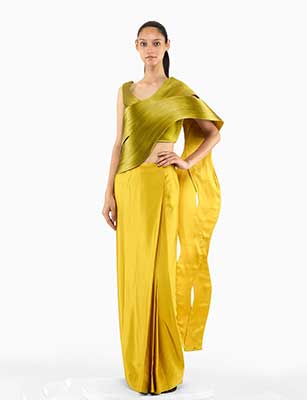
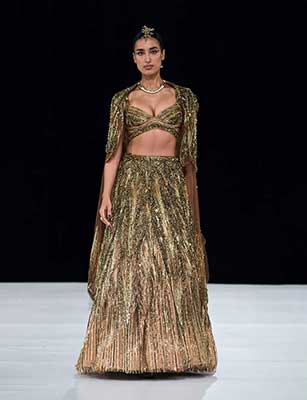
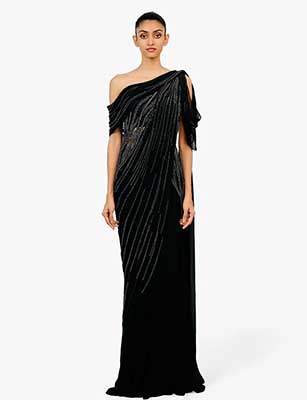


Finally, you keep the soul of the sari while wearing it like a piece of high-fashion couture—no safety pins or elaborate pleating required. For something closer to home, many regional weavers are now offering bespoke drapes with metallic accents—ask for customised zari or asymmetrical pleating.
The takeaway is that you can keep the soul of the sari while wearing it like high-fashion couture—no safety pins, no elaborate pleating. Raw Mango by Sanjay Garg even has handwoven Banarasi and Chanderi weaves in ready-to-wear cuts, while Saaksha & Kinni delivers print-heavy versions with detachable pallus and slouchy jackets. But then, if you would rather stay local, ask your favourite regional weaver for a custom drape with metallic zari or an asymmetrical pallu.
Blouses As Showstoppers
This season the blouse is no longer just a supporting act. Cape blouses, one-shoulder drapes, even sharp tuxedo-style jackets are replacing the standard choli. At Tarun Tahiliani, you will find sherwani-inspired blouses embroidered in antique zardozi, paired with diaphanous saris for a play of masculine and feminine. Anamika Khanna’s latest features dramatic floor-length capes with intricate heritage thread-work, making it almost impossible to decide which angle is the most Instagram-worthy.
Festive evenings are demanding a touch of light, and designers are obliging with every imaginable metallic—rose-gold tissue saris, pewter silk, and copper-threaded brocades. Gaurav Gupta’s futuristic drapes in gunmetal grey and midnight silver practically glow under candlelight. For those who prefer a whisper rather than a shout, Raw Mango offers handwoven Banarasi saris with just a glint of silver zari—enough to catch the eye without stealing the entire spotlight. Or even Nikita Gujral’s scallop nalki zircon embroidered cape.
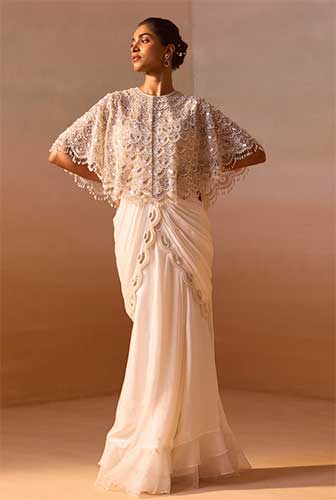

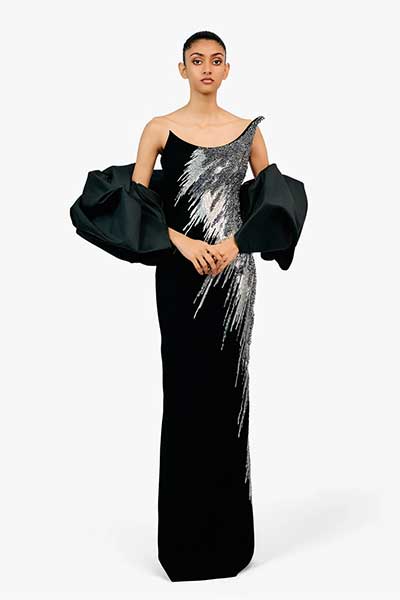
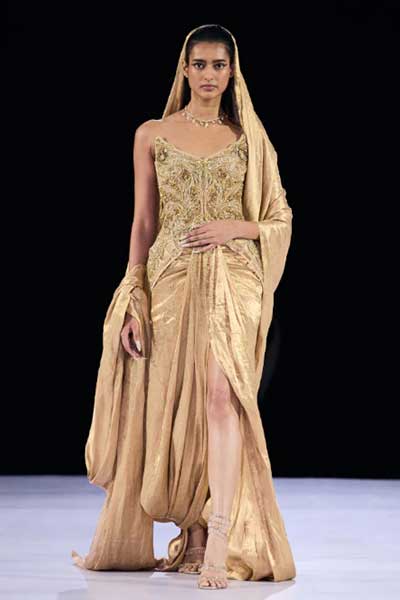
Sherwani Makeover
Men’s festive wear this season is just as adventurous. The sherwani—once a straight, knee-length coat—is now flirting with unexpected shapes. Kunal Rawal leads the charge with asymmetrical hemlines and overlapping closures that feel almost Japanese. His tone-on-tone metallic thread-work adds a subtle shimmer that photographs beautifully under party lights.
Manish Malhotra’s velvet sherwanis in jewel tones like emerald, deep burgundy, sapphire finished with antique gold embroidery also stand out. Pair them with slim churidars or even cropped trousers for a contemporary silhouette. And don’t overlook the layered look: designers like Raghavendra Rathore are styling sherwanis over bandis (waistcoats) and longline shirts for depth and texture.
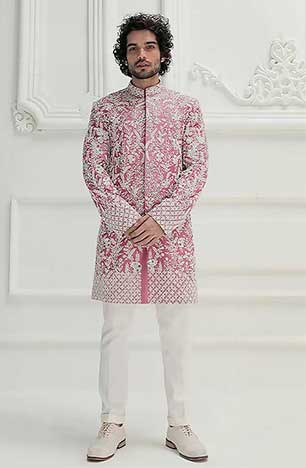
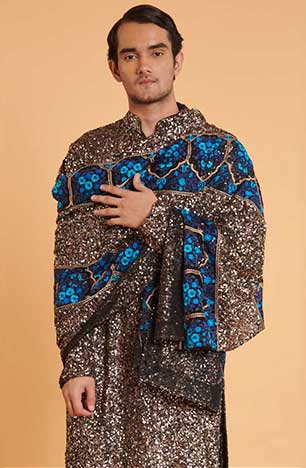
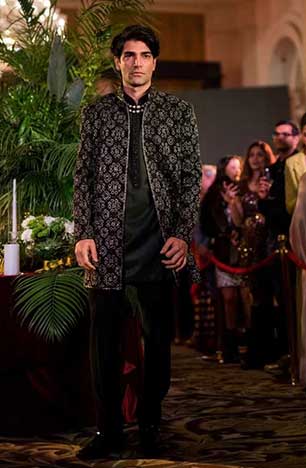
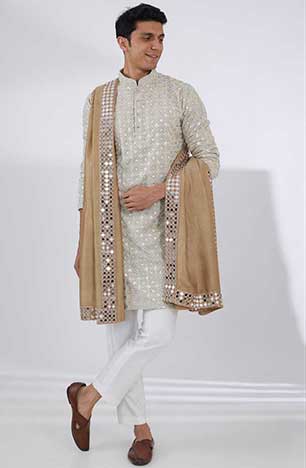
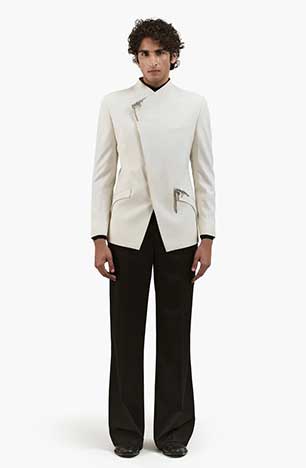
The Final Word
What makes these new-age pieces exciting is how they balance heritage with a global, street-smart sensibility. Embroideries like chikankari, gota patti, and Kashmiri aari remain central, but they’re being reimagined. Picture a black silk sherwani with traditional Kashmiri motifs rendered in metallic cobalt thread, or a sari edged in mirror work but cut to reveal an asymmetrical leg slit.
So, pair a matte silk sari with a sequinned cape blouse. Or wear a velvet sherwani with linen trousers for a modern high-low contrast. Chunky chokers in silver, sculptural ear cuffs, or a single statement ring are enough when the outfit already speaks volumes. Men can swap the traditional stole for a sharply pleated metallic dupatta. The beauty of these designs is their movement. Skip overly rigid draping; let the fabric breathe and flow.


